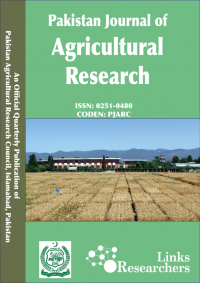COST EFFECTIVENESS OF UNDER-SHEET AND WHOLE GODOWN FUMIGATION OF BAGGED WHEAT
Akhlaq Ahmad, M. Anwar Arain*, Rahila Nazli**, Syed Anser Rizvi***,
Mubarik Ahmed* and Farzana Ibrahim****
Corresponding author: [email protected]
ABSTRACT
Development of resistance against phosphine in stored grain insect pests in Pakistan is the result of whole godown improper fumigation of bagged wheat over the past several years. Trials were conducted in 338 godowns in 8 districts of upper Sindh. Out of these, 169 godowns were selected for fumigation with phosphine inside and under polyethylene sheets, while the others for indoor space fumigation in godowns without covering wheat stack with a sheet. Samples of wheat at the baseline and at two-monthly intervals after fumigation were collected for physical examination. It was observed during the 8 month storage trials that the average moisture content increased by 3%, grain damage increased by 12% -1 and grain weight decreased by 6 kghl in whole godown fumigations compared to similar treatment carried out under the cover of polyethylene sheet. The cost effectiveness of the treatments was determined, considering the cost of the materials and labour. It was estimated that a single fumigation treatment in under-sheet stacks was around Rs. 1.05 million less than the whole godown fumigation, even though it involved extra cost of polyethylene (PE) sheet. This cost may be partially recovered by recycling the used PE sheet. This is mainly because whole godown treatments required two to three extra fumigations due to heavy reinfestation of insect pests. Compared to this, sheeted stocks showed no sign of insect activity during the 8 months storage. From the study, it is concluded that under-sheet fumigation of stacks of bagged wheat is a very cost effective and feasible method for protection of stored cereals, and need to be implemented at the provincial and national levels.
To share on other social networks, click on any share button. What are these?






